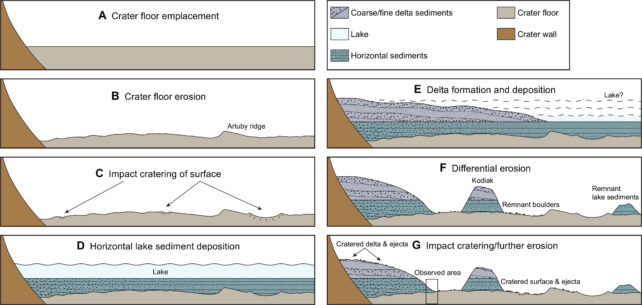
Scientists 'Hopeful' Persy Has Already Found Life on Mars
Share
In a nutshell:
- Percy's exploring a potentially life-friendly Martian lake bed.
- He found buried layers of rock and sediment, suggesting a long-lived lake.
- He collected samples with hints of organic stuff, maybe signs of life!
- We gotta wait for the samples to get back to Earth for the final verdict.
The quest for extra-terrestrial life on Mars takes a captivating turn as the Perseverance rover delves into the secrets of Jezero Crater. This ancient impact site, once a sprawling lakebed, now holds tantalizing evidence of a potentially life-sustaining Martian past. Armed with its array of sophisticated instruments, Perseverance is not merely traversing the Martian landscape; it's actively interrogating its geological history, and the results are rewriting our understanding of the Red Planet.
Ground-penetrating radar, aptly named RIMFAX, has become Perseverance's most potent weapon in this subterranean investigation. Its penetrating gaze pierces through the dusty Martian surface, revealing a hidden world of layered sediments and rocks. These layers whisper tales of a tumultuous past, where water once reigned supreme, carving deltas and sculpting landscapes.

The recent findings, detailed in a study published in Science Advances, paint a captivating picture. Beneath the western edge of Jezero, RIMFAX reveals a complex stratigraphy, a symphony of geological events frozen in time. Younger sediments, likely deposited by water or volcanic activity, blanket the crater floor, nestled atop the remnants of the ancient lakebed. This confirms the long-held suspicion that Jezero wasn't just a fleeting puddle; it was a persistent oasis, enduring eons of Martian history.
More importantly, this longevity could have provided the perfect cradle for microscopic life. On Earth, long-lived aqueous environments often teem with microbial diversity. Jezero, with its potential for sustained wet conditions, becomes a prime candidate for hosting similar Martian flora.
Yet, the true test lies not in speculation, but in concrete evidence. Perseverance, acting as both explorer and archivist, has diligently collected rock and sediment samples from this promising region. These precious capsules, currently filling 60% of the rover's inventory, await their eventual return to Earth, where sophisticated laboratories will scrutinize them for the tell-tale signatures of life.
Intriguingly, some of the collected samples already exhibit hints of organic compounds, the very building blocks of life. However, until these samples undergo rigorous terrestrial analysis, the question of their origin – biological or geological – remains tantalizingly unanswered.
The scientific community eagerly awaits the return of these Martian treasures. Each sample represents a chapter in the Red Planet's enigmatic past, a potential key to unlocking the mystery of past and perhaps even present life on Mars. Perseverance's ground-breaking discoveries serve as a testament to the relentless human quest for knowledge beyond our terrestrial shores. Jezero Crater is not just a Martian landmark; it's a stepping stone on the path toward understanding our place in the vast cosmic tapestry.
So, as the rover continues its valiant trek across the Martian plains, we wait with bated breath for the day its samples shed light on the greatest question of all: are we alone? Jezero might hold the answer, and Perseverance, our tireless Martian cartographer, is leading the way.
You’ve come this far…
Why not venture a little further into A.S.S. - our exclusive Australian Space Society.
And keep thrusting Australia into the deep unknown…
#Space_Aus




